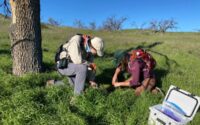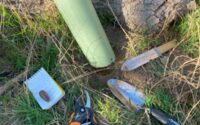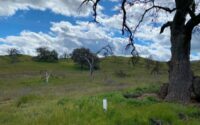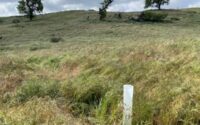





Area: 167.8 acres
Location: Santa Clarita, Los Angeles County, California
Date Acquired: 2013
Acquisition Type: CNLM holds a Conservation Easement as well as a long-term management agreement to protect the Preserve’s conservation values in perpetuity.
Key Habitats: Valley oak savanna; Coastal sage scrub; California annual grassland.
Species of Special Interest to CNLM: Valley oak (Quercus lobata) and valley oak savanna, Southern California rufous-crowned sparrow (Aimophila ruficeps ssp. canescens), and Short-eared owl (Asio flammeus).
Introduction
The Westridge Oak Preserve was initially envisioned as partial mitigation to offset the development of the adjacent Westridge Valencia Residential Development as far back in 2002. It wasn’t until 2013 that the Preserve was established, and CNLM was granted the conservation easement, which permanently protects the conservation values on the Preserve. In the same year, CNLM entered into a Management Agreement to protect the natural ecology on the Preserve through science-based, perpetual management. Currently, management efforts include valley oak tree health monitoring, acorn collection and planting, oak sapling protection and monitoring, invasive species monitoring and treatment, and conducting presence/absence surveys for other biological resources present within the Preserve (including common and sensitive plants, birds, mammals, insects, etc.).
Conservation Significance
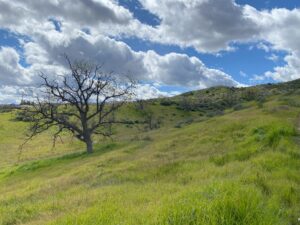 Valley oaks, and by extension valley oak savannas, are endemic to California. They have been a historic and charismatic feature across the low-rolling hills, native grasslands, and alluvial valleys that stretch between the Sacramento River and the Santa Monica Mountains. Valley oaks can reach 400 to 600 years of age, and the largest trees can have massive trunks of up to seven feet in diameter. These trees support all trophic levels of life, from insects to mountain lions, by providing food and shelter. Due to increased habitat fragmentation and impacts associated with climate change, such as increased frequency of wildfires and extended droughts, valley oaks and valley oak savannas have become increasingly rare. This scarcity is most notable at the southern edge of their geographic range.
Valley oaks, and by extension valley oak savannas, are endemic to California. They have been a historic and charismatic feature across the low-rolling hills, native grasslands, and alluvial valleys that stretch between the Sacramento River and the Santa Monica Mountains. Valley oaks can reach 400 to 600 years of age, and the largest trees can have massive trunks of up to seven feet in diameter. These trees support all trophic levels of life, from insects to mountain lions, by providing food and shelter. Due to increased habitat fragmentation and impacts associated with climate change, such as increased frequency of wildfires and extended droughts, valley oaks and valley oak savannas have become increasingly rare. This scarcity is most notable at the southern edge of their geographic range.
Due to the ecological importance of the valley oak savanna contained within the Westridge Oak Preserve, the County of Los Angeles identified the Preserve as a Significant Ecological Area (SEA). The SEA Program seeks to protect irreplaceable biological resources and habitats within Los Angeles County. The Program identifies areas as a SEA based on criteria that determine the biological importance of a habitat. The valley oak savanna within the Westridge Oak Preserve was identified as SEA 64 (now SEA 25), Valley Oaks Savannah, due to the high density of very old and large valley oak trees. The Westridge Oak Preserve is also one of the remaining patches of intact valley oak savanna within their southern geographic range. Some of the remaining trees on the Preserve have been identified as being at least 80 years old (some dating back to the 1940s based on historic aerial photography and additional demographic analyses). This Preserve, and the trees within it, provides multiple research opportunities for better understanding variation in species genetic variation, responses to extreme weather, range contraction, and effective habitat restoration methodology.
In addition, the coastal sage scrub and annual grasslands within the Preserve provide habitat for a variety of plants and wildlife, including common species like acorn woodpeckers and coyotes, and sensitive species like the southern California rufous-crowned sparrow and short-eared owl.
Our Work
In 2017, CNLM Preserve Managers began recording a decline in vitality for many of the valley oaks within the Preserve, presumably due to the extended drought of 2013-2016. In addition, there has been insufficient oak recruitment during the last 70 years to maintain the oak population at its current level. Therefore, CNLM’s current conservation strategies to preserve and maintain the Preserve include: (1) establishing a baseline condition for the ecological and demographic characteristics of the Preserve to guide future management and monitor changes over time, (2) stabilizing the valley oak population through acorn collecting and planting, and (3) determining long-term management goals in the context of climate change and the eventual incorporation of public use on the Preserve. Based on the initial surveys conducted by CNLM staff, we have started collecting acorns locally and planting them within the Preserve to replace the trees lost during the drought.
Public Access
This Preserve is currently closed to public access. However, the Preserve will be transferred to a multi-agency management authority, and then it will become open to the public for recreational and educational activities that are consistent with preservation of the Preserve’s conservation values. For information and inquiries, please contact Preserve Manager, Brigit Harvey-Ayers. Email: bhayers@cnlm.org
Contact
For information about Westridge Oaks Preserve or the Center for Natural Land Management, please contact Brigit Harvey-Ayers, Preserve Manager at bhayers@cnlm.org or 661.206.1284.


